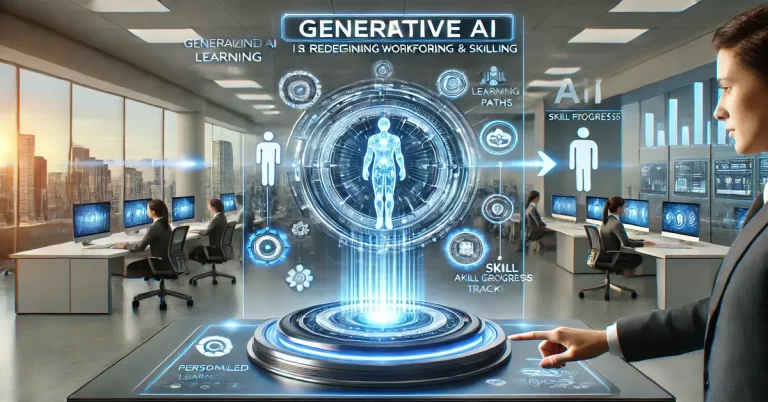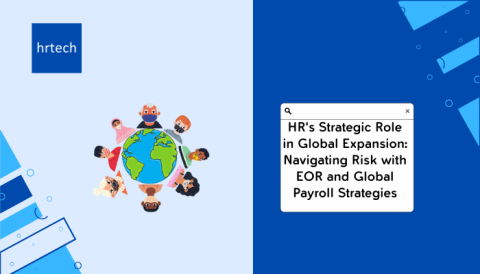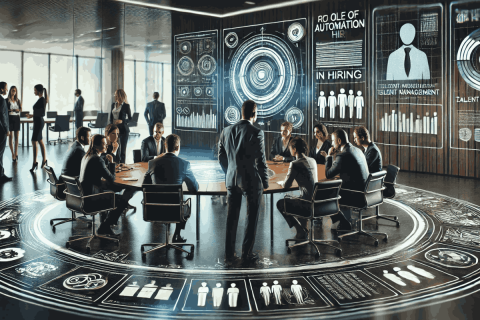The landscape of workforce learning is evolving rapidly, and traditional training methods, such as one-size-fits-all courses, can no longer keep up with the dynamic needs of modern businesses. As industries embrace digital transformation, HR and Learning & Development (L&D) professionals adopt innovative solutions to drive employee growth. This shift is a prime example of GenAI and the future of work, where cutting-edge technologies transform how we train, develop, and engage the workforce.
According to a survey conducted by McKinsey, 79% of respondents have had at least some exposure to GenAI, with 22% regularly using it for work. The technology is already making waves across industries, particularly in North America, where adoption rates are highest.
As we explore the impact of GenAI on workforce learning, we’ll dive into how AI is transforming employee education and why AI and the future of work are intrinsically linked. Platforms like Disprz are at the forefront, leveraging GenAI to create more personalized, efficient, and impactful learning experiences.
What is Generative AI (GenAI)?
Generative AI (GenAI) is an advanced machine learning model that creates new content, ideas, or outputs based on patterns and data inputs. Unlike traditional AI systems, which rely heavily on structured algorithms and predefined rules, GenAI models are designed to generate human-like text, images, and even video content.
These models can learn from vast datasets, producing creative outputs often indistinguishable from human-generated work. In the context of workforce learning,
GenAI and the future of work are intricately connected, as this technology takes learning and development to the next level by enabling highly customized experiences, automating content creation, and providing real-time feedback.
The adoption of GenAI is already gaining momentum across industries. According to Cloud4c, 78% of higher education institutions have implemented or are in the process of deploying GenAI technologies to improve teaching and learning outcomes, highlighting a broader trend towards personalized, AI-driven education.
For HR and L&D professionals looking to stay ahead, exploring hrtech marketplace is a great way to find innovative solutions that integrate GenAI into learning strategies. Connect with platforms today to embrace the future of workforce development and boost success in an AI-driven world.
Core Functionalities of Generative AI (GenAI)
Generative AI (GenAI) tools like Vondy AI brings powerful capabilities to learning and development by performing various tasks that enhance how we create and interact with content. Here are the core functionalities of GenAI:
Content Creation Across Various Modalities:
- Text: GenAI can generate written content such as articles, quizzes, training modules, and personalized feedback tailored to the learner’s needs.
- Images and Visuals: It can create relevant visuals or infographics that help explain complex concepts more engagingly.
- Audio: GenAI can generate audio content, like podcasts or voiceovers, to complement training materials and cater to different learning preferences.
Data Augmentation: GenAI can take existing data and create new versions, such as generating additional examples, scenarios, or variations to enrich learning content. This helps provide diverse learning experiences without manually creating new content every time.
Creative Problem-Solving: GenAI can help generate innovative solutions to complex problems by analysing patterns and identifying connections in data. In learning, this means it can help design creative learning modules or suggest new ways to present information based on learner preferences.
Text Generation: GenAI excels in creating natural, human-like text. For learning this can mean generating customized learning materials, summaries, or even conversation simulations for training purposes, making content more engaging and dynamic.
Language Translation: GenAI can translate content into different languages, ensuring that learning materials are accessible to a wider audience. This is particularly valuable for global teams or organizations with a diverse workforce.
Summarizing Information: GenAI can take large amounts of information, like research papers or lengthy training documents, and generate concise summaries, making it easier for learners to absorb key points without excess content.
Generating New Ideas Based on Existing Data: Using the information it learns from existing content, GenAI can propose new ideas, solutions, or content structures. In the context of learning, this can help develop new learning paths and course materials or suggest additional topics for deeper exploration.
Comparison with traditional AI applications in learning
Below is the table of comparison with traditional AI applications in learning
| Aspect | Traditional AI | Generative AI |
| Definition | Narrow AI focused on specific tasks and problem-solving. | AI that generates new content, such as text, images, and music. |
| Learning Approach | Primarily uses supervised learning with structured data. | Utilizes unsupervised learning and deep learning techniques to create outputs. |
| Data Dependency | Relies heavily on labelled, structured data for training. | Can work with unstructured data and generate new data samples. |
| Applications | Image recognition, recommendation systems, chatbots, and predictive maintenance. | Content creation, language translation, simulations, and creative applications. |
| Flexibility | Limited to predefined rules and tasks; excels in well-defined problems. | More adaptable; can explore open-ended tasks and generate novel solutions. |
Transformative Impacts of GenAI on Workforce Learning
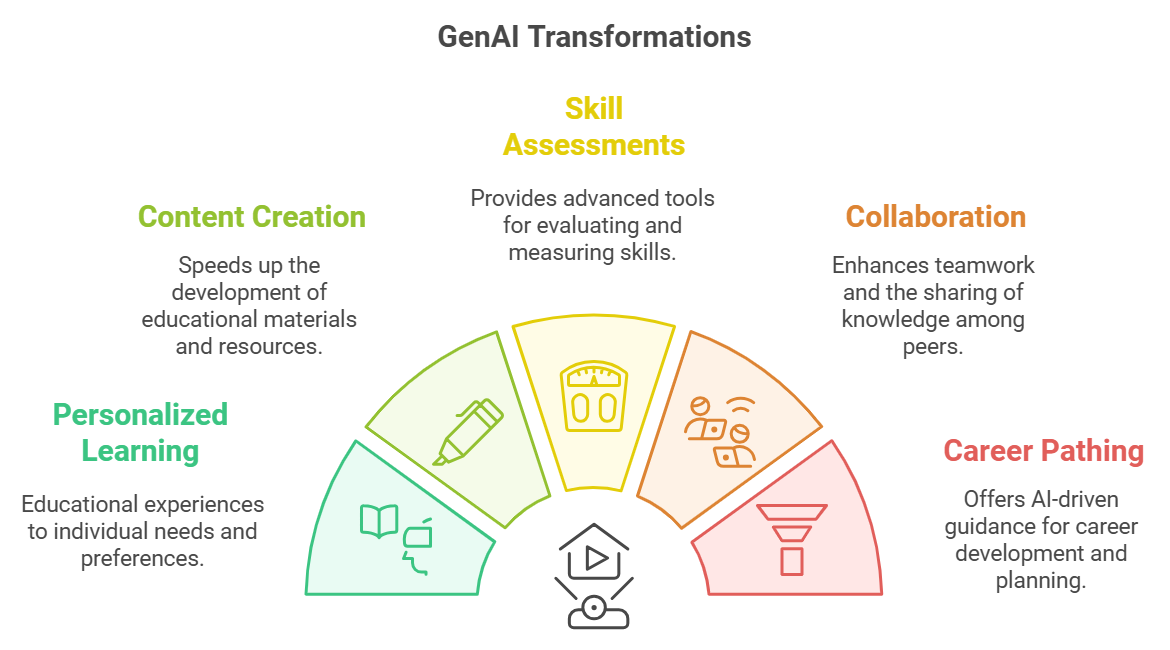
According to McKinsey Global Institute, GenAI is expected to automate nearly 30% of the work in the U.S. economy by 2030. This shift highlights the growing impact of GenAI in boosting efficiency and productivity across organizations.
GenAI isn’t just a tool for automating tasks; it’s a powerful way to create personalized learning, speed up content creation, and assess skills in real-time. Here are some of the main ways GenAI is changing how we learn at work:
1. Personalized Learning Experiences
One of the most significant benefits of GenAI in workforce learning is its ability to deliver highly personalized learning experiences.
- Data-Driven Personalization: GenAI can analyze data from a learner’s past performance, behaviour patterns, and learning preferences to curate a path that best suits their needs.
- Adaptive Learning: If an employee struggles with a particular concept, the system can automatically adjust the content or recommend additional resources, ensuring they stay on track.
- Continuous Adjustments: As learners progress, GenAI adapts content dynamically, ensuring that it remains relevant and challenging, improving engagement and retention over time.
By offering a more targeted and relevant learning journey, GenAI enhances the impact of learning, driving higher levels of employee engagement and long-term skill development.
2. Accelerated Content Creation
Creating high-quality training content traditionally takes time and resources. GenAI speeds up this process by enabling the creation of on-demand content. Materials like videos, quizzes, interactive exercises, and written modules can be generated almost instantly, helping L&D teams scale programs without sacrificing quality.
- Efficient Scaling: GenAI enables training programs to scale seamlessly as organisations grow, delivering new learning content quickly across departments and regions.
- Real-Time Updates: GenAI ensures that learning content is always current, reducing the need for L&D teams to update training materials manually. For instance, changes in industry trends, corporate strategies, or even regulatory requirements can be swiftly incorporated into existing modules.
- Cost Savings: With automated content creation, companies can save on resources and overhead, allowing them to reallocate budgets to other strategic initiatives.
As AI and the future of work continue to evolve, the ability to produce dynamic, timely, and engaging learning content will become a critical advantage for businesses looking to stay ahead of the curve.
3. Enhanced Skill Assessments
Skill assessments are a cornerstone of workforce learning, but traditional methods often fail to provide actionable insights or real-time feedback. GenAI revolutionizes skill assessments by offering continuous, granular evaluations of an employee’s abilities.
- Real-Time Feedback: GenAI enables real-time evaluations, offering employees immediate feedback on their performance. This helps them correct mistakes and adjust their approach, ensuring faster skill acquisition.
- Comprehensive Skill Evaluation: GenAI assesses hard and soft skills, including technical proficiency, problem-solving, critical thinking, communication, and emotional intelligence. By evaluating these diverse skill sets, GenAI gives L&D professionals a complete picture of employee capabilities.
- Adaptive Skill Assessments: Based on ongoing performance, GenAI continuously adapts assessments, challenging employees just enough to encourage growth without overwhelming them. This dynamic feedback loop helps employees develop competencies progressively.
- Actionable Insights for Managers: L&D teams and managers receive detailed analytics, allowing them to identify trends, gaps, and areas for improvement across the workforce. This data-driven approach leads to more informed decision-making around training needs and talent development strategies.
With the impact of GenAI on workforce learning, companies can now provide precise and actionable insights into employee performance, leading to more effective development strategies and a higher return on investment for training initiatives.
For a comprehensive guide on how AI is revolutionizing HR practices, including engagement strategies for Gen Z and beyond, check out this AI in HR blog.
Disprz is leading the way by leveraging GenAI to deliver personalized learning, accelerate content creation, and provide real-time skill assessments that empower teams and drive business success in the AI-driven future.
Disprz’s GenAI-Powered Solutions
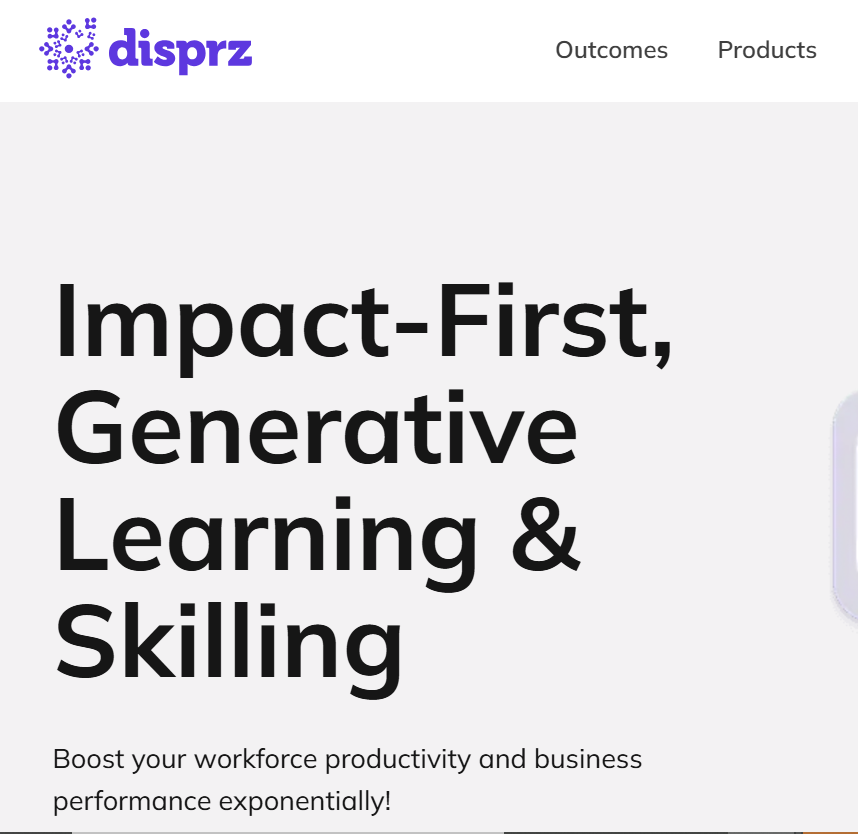
Disprz is at the forefront of integrating GenAI into workforce learning and skilling solutions. Their platform combines the power of AI with cutting-edge learning design to deliver an experience that is personalised and scalable.
Key Features of Disprz’s GenAI Solutions:
- GenAI-Powered Learning Pathways: Personalized content curation based on employee performance and skill gaps, ensuring relevant training is delivered at the right time.
- Content and Assessment Authoring: Rapid content and assessment creation and curation in multiple formats, saving time and effort on manual L&D tasks.
- Real-time Skill Assessment: Continuous evaluation of employees’ skills enables L&D teams to track progress and efficiently adapt learning strategies.
- Content Summarization and Discovery: Quick summaries for all content formats (e.g., articles/videos /podcasts) and smart content discovery using deep search.
Disprz has successfully implemented GenAI solutions for several leading companies, helping them transform their training programs. Clients have praised Disprz for its intuitive design and measurable impact, highlighting its ability to improve performance with minimal administrative overhead.
Case Studies Demonstrating Successful Implementations
Below are the case studies on how Disprz’s GenAI is making a difference.
Deloitte leveraged Disprz’s AI-powered Learning Experience Platform (LXP) to drive a successful workforce transformation for the Mining Industry in Indonesia (MIND ID). By personalizing learning journeys and adopting a role-based approach, Deloitte achieved a remarkable 95% course completion rate and 100% self-enrollment post-onboarding.
The platform automated learning processes, offering tailored onboarding, AI-driven content recommendations, diverse assessments, and engaging social features, fostering a dynamic learning culture.
Client Testimonials: How Disprz’s GenAI is Making a Difference
Below are the testimonials on how Disprz’s GenAI is making a difference.
1. Nicolas Rimasson – VP of Learning, Prosus
“Disprz has been a game-changer for us. Their platform has allowed us to deliver consistent, impactful learning missions across the globe. Their solution’s ease of use and scalability make it an invaluable tool for driving our learning strategy. The ability to personalize learning journeys has truly helped us align skill development with our business goals.”
2. Farzin Farahmanda – Human Resource Director
“Our transition to Disprz has revolutionized how we approach continuous learning. The centralized skilling platform allows us to track employee progress, foster a growth mindset, and ensure everyone can access the right resources. It’s been crucial for maintaining engagement and achieving our talent development objectives.”
3. Rajagopal Rajesh – Program Manager of Learning and Operations, Uber
“Disprz has helped us deliver tailored skilling solutions for Uber’s extended workforce. The platform’s flexibility and integration capabilities have made it easier for us to provide relevant learning at scale. It’s empowered our teams to upskill and stay ahead in a fast-paced industry continuously.”
Future Trends and Considerations
As Generative AI (GenAI) becomes more integrated into the workforce, understanding its ethical, economic, and social implications is essential. AI is not just a tool for efficiency, it’s reshaping job roles, influencing worker rights, and may either widen or bridge social inequalities. To fully grasp these impacts, ongoing research is crucial as we navigate AI and the future of work.
Predictions for the Future of GenAI in Workforce Development
As GenAI continues to advance, its impact on workforce development is set to grow exponentially. We can expect even more personalized learning experiences, where AI will offer real-time skill assessments and dynamically adapt learning pathways based on individual progress. In the coming years, AI will likely automate more aspects of training, such as curating content, providing instant feedback, and identifying skills gaps, allowing organizations to deliver highly targeted and scalable learning programs.
Additionally, as AI technology becomes more integrated with immersive tools like virtual reality (VR) and augmented reality (AR), training will become more interactive, hands-on, and engaging for employees.
Ethical Considerations for Integrating GenAI into Learning Strategies
- Data Privacy and Security: Protect sensitive learner data throughout its collection, processing, and storage. Ensure compliance with data protection regulations (e.g., GDPR, CCPA). Limit access to learner data to only authorized personnel.
- Transparency in AI Decisions: Provide visibility into AI algorithms and their decision-making processes. Ensure learners can review or challenge AI-driven outcomes, fostering trust in the system.
Best Practices for Integrating GenAI into Learning Strategies
- Bias Mitigation in AI Models: Regularly audit AI systems to identify and correct any potential biases in recommendations or assessments. Train AI models on diverse datasets to ensure they support inclusive learning.
- Human Oversight: Maintain a balance between AI-driven learning and human intervention to ensure decisions are well-rounded. Involve instructors or managers in overseeing AI-generated learning paths to ensure they align with organizational goals.
Additionally, in a rapidly changing environment, understanding the role of AI and machine learning in specialized fields such as quantitative finance can help shape workforce development strategies. Learn how AI transforms career paths in the finance sector by reading The Role of AI and Machine Learning in Shaping Quant Finance Careers.
The Brookings report highlights the need for more research into AI’s effect on various industries and occupational groups. This includes identifying which skills will be in demand as AI automates tasks and predicting which job roles may face significant disruption. Insights from such research are critical for designing policies and educational programs that help workers adapt.
Conclusion
Generative AI is undeniably reshaping how organizations approach workforce learning and development. Its ability to deliver personalized learning experiences, accelerate content creation, and provide real-time skill assessments makes it an indispensable tool for modern businesses. As AI and the future of work continue to evolve, companies are increasingly turning to GenAI to enhance employee development and drive performance.
Disprz’s GenAI-powered solutions are leading the charge in this transformation, helping companies create more efficient and impactful training programs. HR and L&D leaders looking to stay ahead of the curve should consider integrating GenAI into their learning strategies. Doing so will enhance their workforce’s skills and position their organizations for long-term success in an increasingly digital world.Contact our team today to learn more about how Disprz can help you redefine workforce learning! Visit our hrtech contact us page to schedule a consultation and discover how our GenAI-powered solutions can transform your organization’s learning and development strategy.
